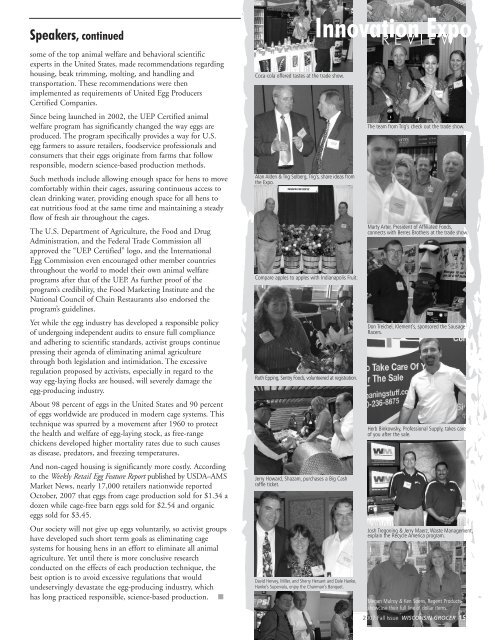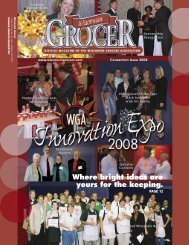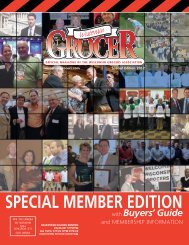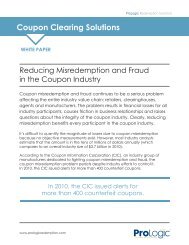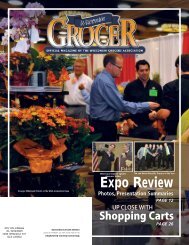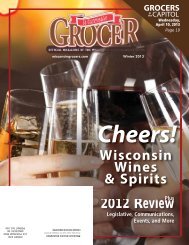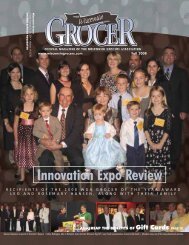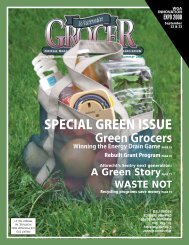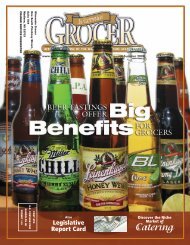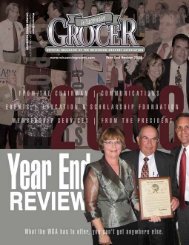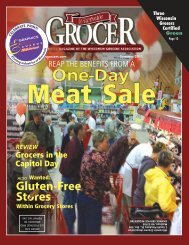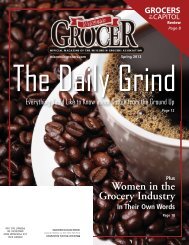made an energetic and motivating beginning to the Chairman's
made an energetic and motivating beginning to the Chairman's
made an energetic and motivating beginning to the Chairman's
Create successful ePaper yourself
Turn your PDF publications into a flip-book with our unique Google optimized e-Paper software.
Speakers, continuedsome of <strong>the</strong> <strong>to</strong>p <strong>an</strong>imal welfare <strong>an</strong>d behavioral scientificexperts in <strong>the</strong> United States, <strong>made</strong> recommendations regardinghousing, beak trimming, molting, <strong>an</strong>d h<strong>an</strong>dling <strong>an</strong>dtr<strong>an</strong>sportation. These recommendations were <strong>the</strong>nimplemented as requirements of United Egg ProducersCertified Comp<strong>an</strong>ies.Since being launched in 2002, <strong>the</strong> UEP Certified <strong>an</strong>imalwelfare program has signific<strong>an</strong>tly ch<strong>an</strong>ged <strong>the</strong> way eggs areproduced. The program specifically provides a way for U.S.egg farmers <strong>to</strong> assure retailers, foodservice professionals <strong>an</strong>dconsumers that <strong>the</strong>ir eggs originate from farms that followresponsible, modern science-based production methods.Such methods include allowing enough space for hens <strong>to</strong> movecomfortably within <strong>the</strong>ir cages, assuring continuous access <strong>to</strong>cle<strong>an</strong> drinking water, providing enough space for all hens <strong>to</strong>eat nutritious food at <strong>the</strong> same time <strong>an</strong>d maintaining a steadyflow of fresh air throughout <strong>the</strong> cages.The U.S. Department of Agriculture, <strong>the</strong> Food <strong>an</strong>d DrugAdministration, <strong>an</strong>d <strong>the</strong> Federal Trade Commission allapproved <strong>the</strong> “UEP Certified” logo, <strong>an</strong>d <strong>the</strong> InternationalEgg Commission even encouraged o<strong>the</strong>r member countriesthroughout <strong>the</strong> world <strong>to</strong> model <strong>the</strong>ir own <strong>an</strong>imal welfareprograms after that of <strong>the</strong> UEP. As fur<strong>the</strong>r proof of <strong>the</strong>program’s credibility, <strong>the</strong> Food Marketing Institute <strong>an</strong>d <strong>the</strong>National Council of Chain Restaur<strong>an</strong>ts also endorsed <strong>the</strong>program’s guidelines.Yet while <strong>the</strong> egg industry has developed a responsible policyof undergoing independent audits <strong>to</strong> ensure full compli<strong>an</strong>ce<strong>an</strong>d adhering <strong>to</strong> scientific st<strong>an</strong>dards, activist groups continuepressing <strong>the</strong>ir agenda of eliminating <strong>an</strong>imal agriculturethrough both legislation <strong>an</strong>d intimidation. The excessiveregulation proposed by activists, especially in regard <strong>to</strong> <strong>the</strong>way egg-laying flocks are housed, will severely damage <strong>the</strong>egg-producing industry.About 98 percent of eggs in <strong>the</strong> United States <strong>an</strong>d 90 percen<strong>to</strong>f eggs worldwide are produced in modern cage systems. Thistechnique was spurred by a movement after 1960 <strong>to</strong> protect<strong>the</strong> health <strong>an</strong>d welfare of egg-laying s<strong>to</strong>ck, as free-r<strong>an</strong>gechickens developed higher mortality rates due <strong>to</strong> such causesas disease, preda<strong>to</strong>rs, <strong>an</strong>d freezing temperatures.And non-caged housing is signific<strong>an</strong>tly more costly. According<strong>to</strong> <strong>the</strong> Weekly Retail Egg Feature Report published by USDA–AMSMarket News, nearly 17,000 retailers nationwide reportedOc<strong>to</strong>ber, 2007 that eggs from cage production sold for $1.34 adozen while cage-free barn eggs sold for $2.54 <strong>an</strong>d org<strong>an</strong>iceggs sold for $3.45.Our society will not give up eggs voluntarily, so activist groupshave developed such short term goals as eliminating cagesystems for housing hens in <strong>an</strong> effort <strong>to</strong> eliminate all <strong>an</strong>imalagriculture. Yet until <strong>the</strong>re is more conclusive researchconducted on <strong>the</strong> effects of each production technique, <strong>the</strong>best option is <strong>to</strong> avoid excessive regulations that wouldundeservingly devastate <strong>the</strong> egg-producing industry, whichhas long practiced responsible, science-based production.Coca-cola offered tastes at <strong>the</strong> trade show.Al<strong>an</strong> Alden & Trig Solberg, Trig’s, share ideas from<strong>the</strong> Expo.Compare apples <strong>to</strong> apples with Indi<strong>an</strong>apolis Fruit.Ruth Epping, Sentry Foods, volunteered at registration.Jerry Howard, Shazam, purchases a Big Cashraffle ticket.David Hervey, Miller, <strong>an</strong>d Sherry Hers<strong>an</strong>t <strong>an</strong>d Dale H<strong>an</strong>ke,H<strong>an</strong>ke’s Supervalu, enjoy <strong>the</strong> Chairm<strong>an</strong>’s B<strong>an</strong>quet.Innovation ExpoREVIEWThe team from Trig’s check out <strong>the</strong> trade show.Marty Arter, President of Affiliated Foods,connects with Berres Bro<strong>the</strong>rs at <strong>the</strong> trade show.Don Treichel, Klement’s, sponsored <strong>the</strong> SausageRacers.Herb Binkowsky, Professional Supply, takes careof you after <strong>the</strong> sale.Josh Tregoning & Jerry Maerz, Waste M<strong>an</strong>agement,explain <strong>the</strong> Recycle America program.Meg<strong>an</strong> Mulroy & Ken Soens, Regent Products,showcase <strong>the</strong>ir full line of dollar items.2007 Fall Issue WISCONSIN GROCER 15


